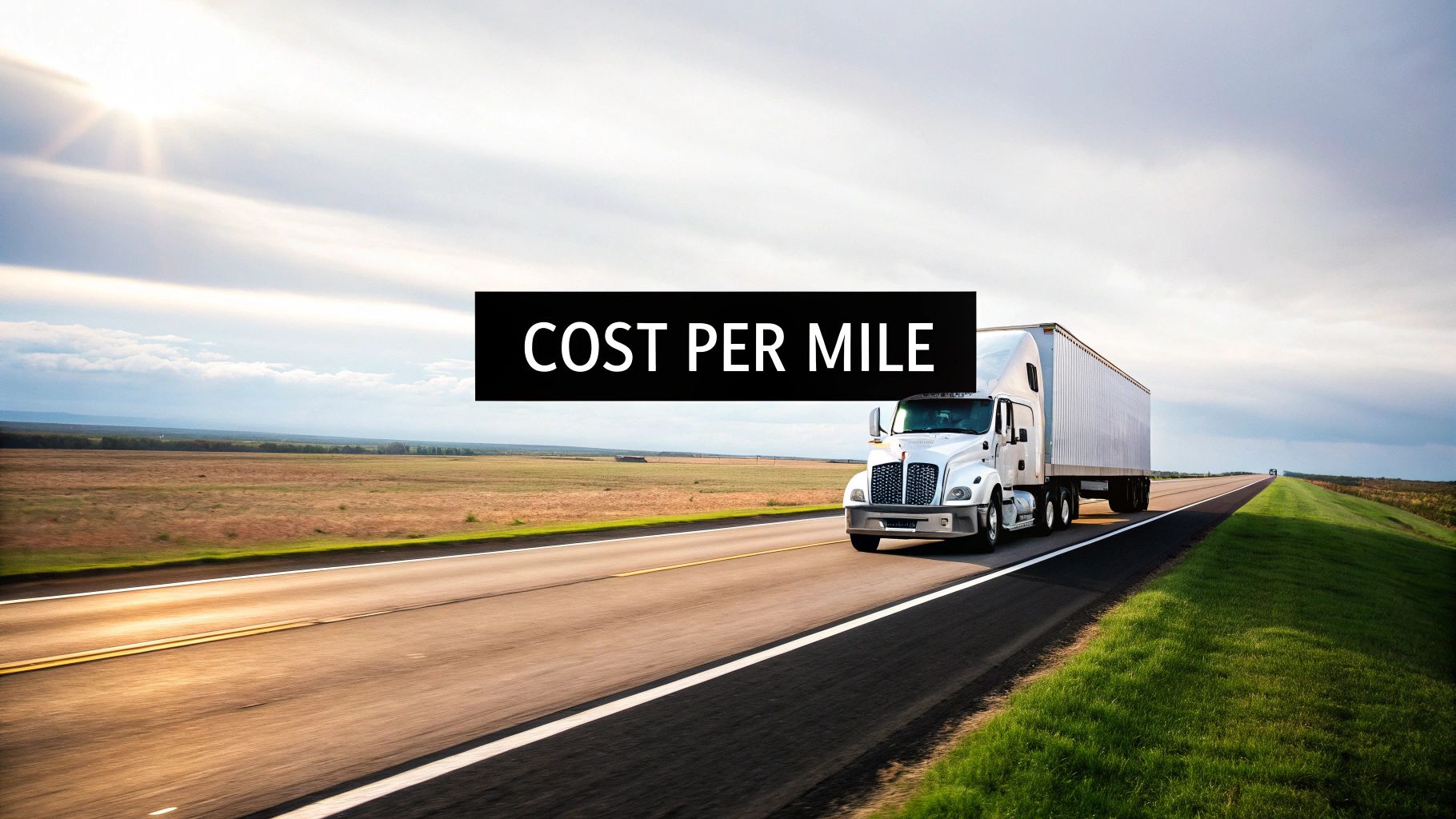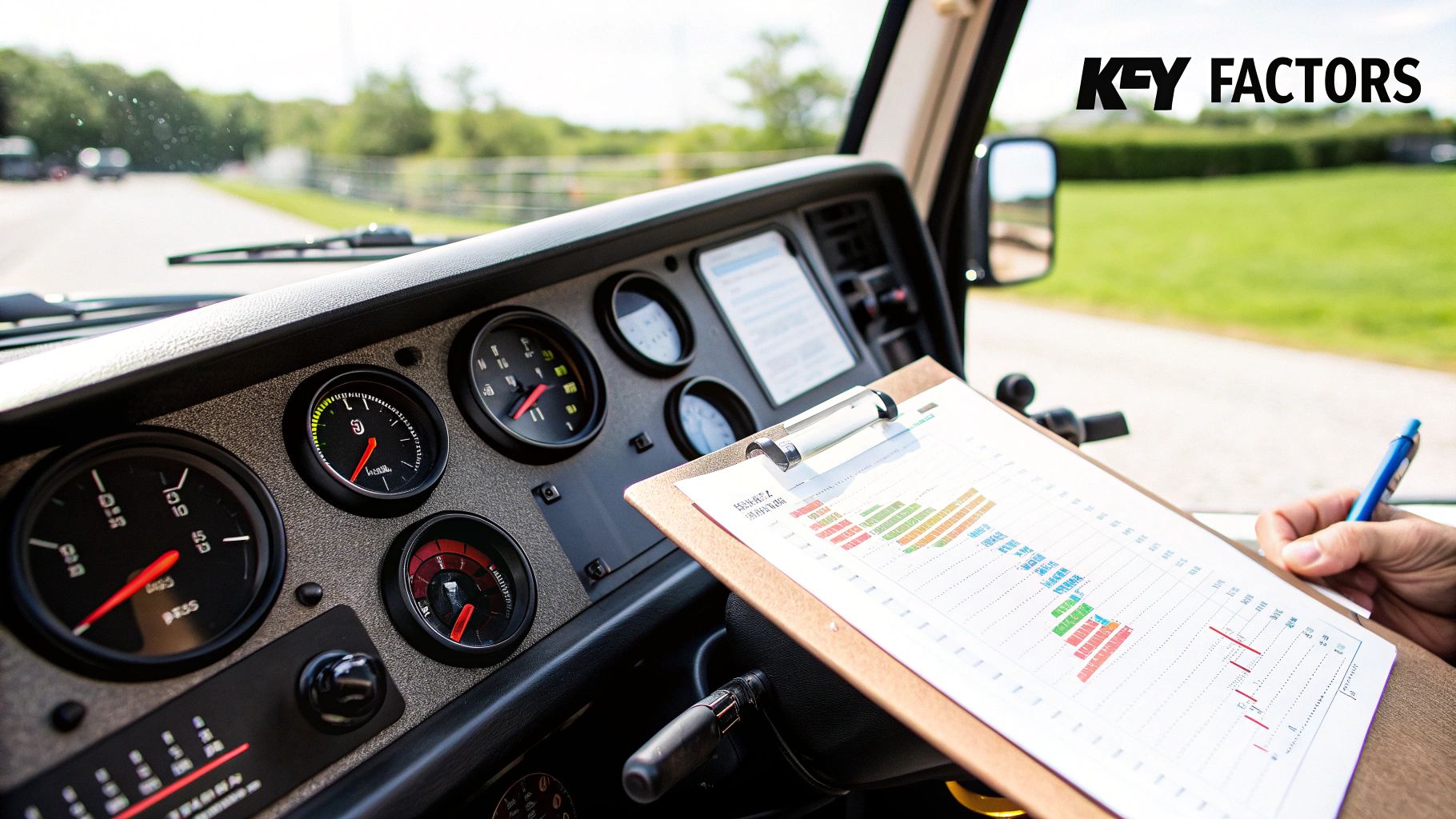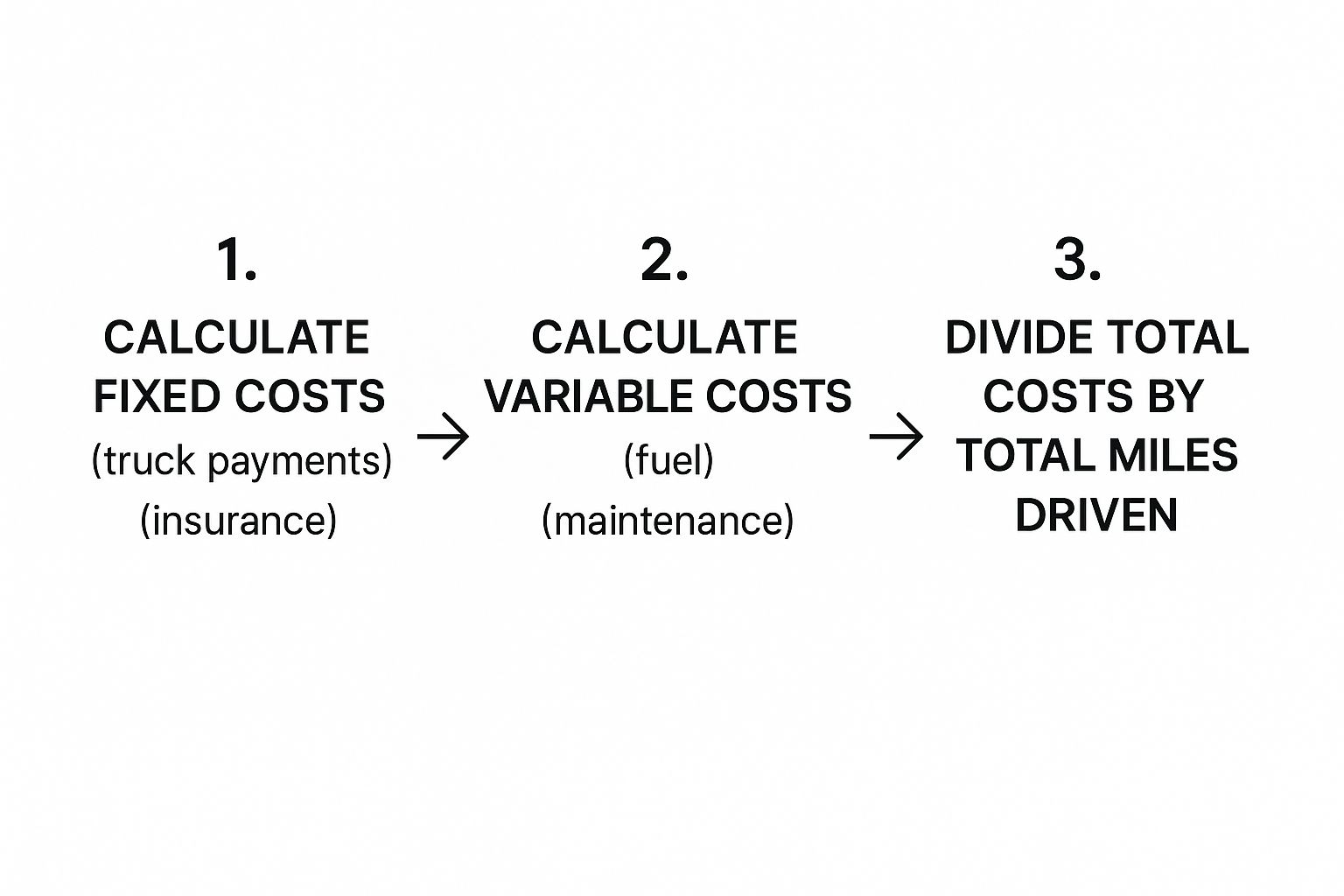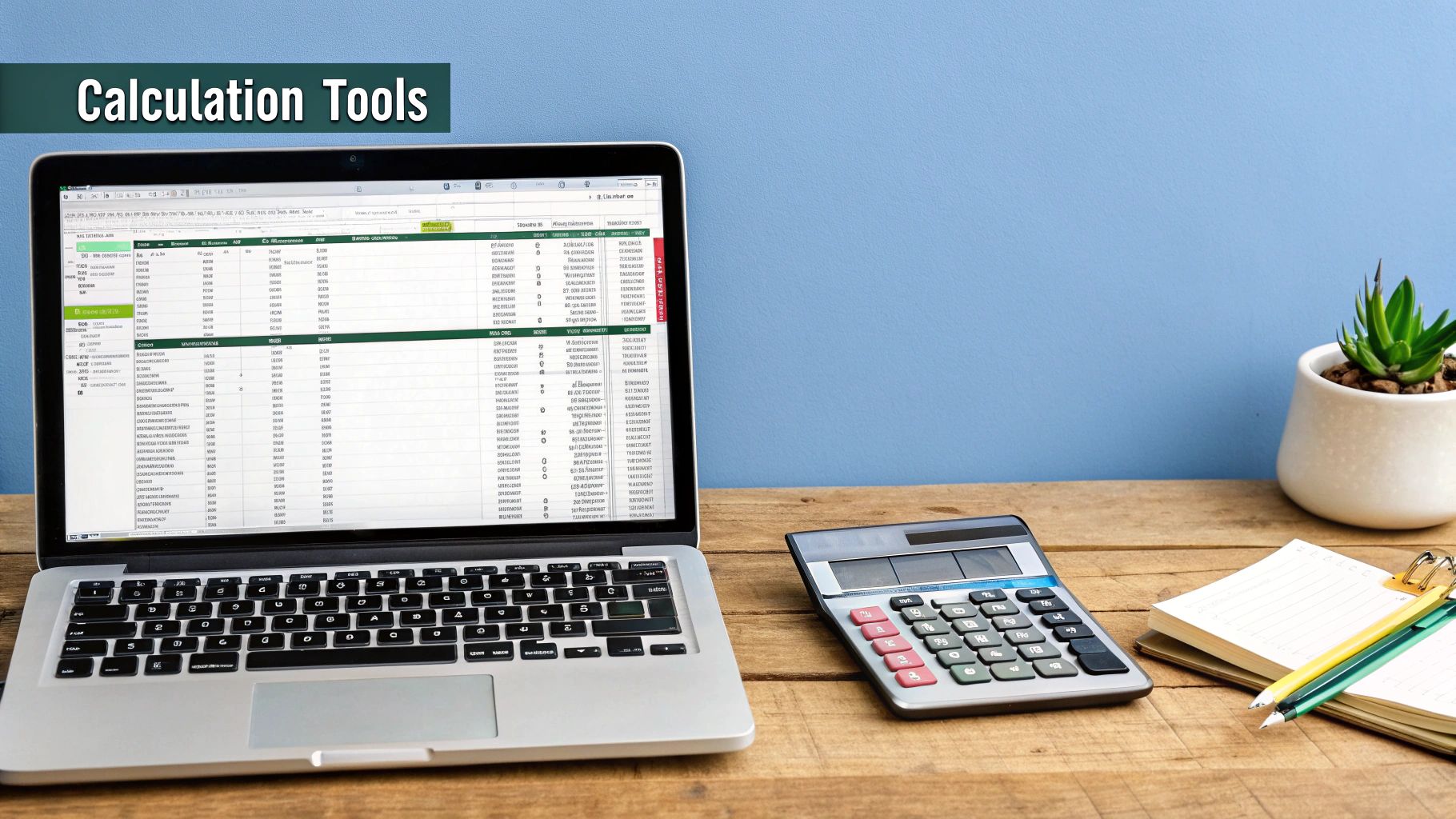Use our cost per mile calculator trucking guide to accurately estimate expenses, boost profits, and optimize your trucking operations today!

Let's be blunt: your cost per mile (CPM) is the single most important number in your trucking business. It’s what separates a profitable year from a struggle to stay afloat. Using a cost per mile calculator for your trucking operation takes you from guessing to knowing, turning hazy estimates into cold, hard facts.
Without this number, you're driving blind. You have no real way of knowing if that load you're about to book is padding your wallet or slowly bleeding you dry.

When you know your CPM down to the penny, you gain real power. You can negotiate rates with confidence, know when to walk away from cheap freight, and get a true picture of your company's financial health at any moment. It's the key to moving from just being a driver to being a savvy business owner.
Think of this guide as the foundation for taking back financial control. Once you master your CPM, you stop reacting to whatever the market throws at you and start proactively setting your own profit targets. You can bid on loads knowing for certain that you’re not just covering your costs, but actually building a stronger, more resilient business.
Knowing your cost per mile isn't just about dodging losses—it's a powerful tool for smart growth. It helps you analyze lanes, figure out which types of freight are worth your time, and see how small changes can have a huge ripple effect on your bottom line.
A precise CPM calculation gives you the confidence to:
Of course, your costs don't exist in a bubble. While the trucking industry's average cost per mile recently dipped slightly to $2.26, that number can fool you. If you pull fuel prices out of the equation, the non-fuel costs—the stuff that really bites—jumped 3.6% to a record $1.779 per mile. This points to the rising expenses we all feel in maintenance, insurance, and truck payments. You can get more details on these operational trucking cost trends and see how they’re putting the squeeze on carriers.
This data is a perfect example of why you can't just watch the pump. Fuel prices get all the attention, but it’s the other "hidden" costs that are creeping up. A good cost per mile calculation keeps these expenses in the spotlight so you're never caught by surprise.
At the end of the day, your CPM is your financial North Star. It should guide every single decision you make, from the freight you haul today to the investments you plan for tomorrow. Ready to see how your numbers stack up?

Before you can even think about calculating your cost per mile (CPM), you have to get a handle on where your money is actually going. This is non-negotiable. Every single expense in your trucking business falls into one of two buckets: fixed costs or variable costs.
Getting this right is the foundation of everything. It’s what separates the pros who know their business inside and out from the drivers who are just guessing.
Think of fixed costs as your overhead—the bills that show up every month like clockwork, whether you haul one load or a hundred. Your truck could be sitting in the yard for a week straight, and you’d still have to pay these. They're the baseline cost of keeping your doors open.
Here's a look at the usual suspects:
Truck & Trailer Payments: For most owner-operators, this is the big one. Whether you're financing a new or used rig, that monthly note is a constant. A decent used truck can easily run you $1,900 to $2,500 per month.
Insurance: Another heavyweight expense. Commercial truck insurance isn't cheap, especially if you have a newer authority. It's not uncommon to see monthly premiums ranging from $1,500 to over $2,500.
Permits & Licensing: All that official paper—IRP, UCR, and other permits—adds up. While you might pay some of them annually, you need to break it down into a monthly cost for your budget.
Your Salary: This is critical, and too many new owner-operators forget it. You have to pay yourself a steady salary. It's a business expense. A realistic starting point is $50,000 a year, which comes out to about $4,167 a month.
Software & Subscriptions: Don't forget the small stuff. Your ELD, load board access (DAT or Truckstop.com), and accounting software are all fixed costs. Budgeting around $300 a month for these is a safe bet.
Variable costs are a different animal. These are the expenses tied directly to turning the key and hitting the road. The more miles you run, the higher these costs climb. They change with every trip and every gallon of fuel.
Here’s an easy way to remember it: Fixed costs are what you pay to own the truck. Variable costs are what you pay to run the truck. You need to know both to get a real cost per mile.
Let's break down the common ones:
Fuel: This is your biggest variable cost, hands down. It goes up and down with the market and your truck's MPG. If you drive 10,000 miles in a month at 7 MPG with diesel at $4.00/gallon, you're looking at a fuel bill of over $5,700. Ouch.
Tires & Maintenance: These expenses don't hit you every month, but you'd better be saving for them. Blowouts and breakdowns are a matter of when, not if. A smart move is to set aside $0.10 to $0.15 for every mile you drive. This creates a maintenance fund so you're not caught off guard.
Tolls: This one is all about the lanes you run. If you're constantly running the Northeast, your toll expenses will be massive compared to a driver sticking to the Midwest.
Factoring Fees: Using a factoring service for quick cash flow? That fee, usually 2-4% of the invoice, is a variable cost. The more freight you move and factor, the more you'll pay.
To make this crystal clear, you need to see your own numbers laid out. I’ve put together this simple table to help you get started. Go through your bank statements and receipts from the last few months and fill in the "Your Monthly Cost" column. Don't guess—find the real numbers.
Once you’ve filled this out, you're no longer flying blind. You have a real, tangible snapshot of your business's financial health. This clarity is what allows you to use a trucking cost per mile calculator effectively and, more importantly, make decisions that actually improve your bottom line.
Alright, let's roll up our sleeves. It’s time to stop guessing and start calculating your actual cost per mile (CPM). You don't need fancy software for this—just a bit of straightforward math that will give you complete control over your business's finances.
To make this real, let's walk through a scenario with an owner-operator we'll call Dave. By adding up his fixed and variable costs—just like we discussed in the previous section—we can pinpoint his exact CPM.
The formula itself is beautifully simple:
(Total Fixed Costs + Total Variable Costs) / Total Miles Driven = Cost Per Mile
Think of this calculation as your secret weapon for evaluating freight. It reveals the absolute rock-bottom price you must earn on every single mile just to break even.
Let's plug in Dave's numbers from our earlier example:
So, Dave’s calculation looks like this: $16,717 / 10,000 miles = $1.67 per mile.
This $1.67 is Dave’s break-even number. Any rate below this means he's literally paying to haul a load. Anything above it is pure profit.
Now that Dave knows his number is $1.67, he's armed with some serious power. Imagine a broker calls with a 500-mile run for $900. A driver who hasn't done the math might just see the dollar signs and grab it.
But Dave is smarter. He quickly calculates: $900 / 500 miles = $1.80 per mile. Since that’s comfortably above his $1.67 CPM, he knows it’s a profitable load and can take it with confidence.
On the flip side, if another load pops up paying $1.50 per mile, he doesn't have to hesitate. He can turn it down instantly, knowing it would actively lose him money. This simple check completely changes how you look at every offer. If you want to see how this fits into the bigger picture, you can learn more about how to ship freight.
The Bottom Line: Your CPM isn't just a number on a worksheet. It's the filter you should run every single load offer through. It clearly tells you which loads are building your business and which ones are slowly bleeding it dry, one mile at a time.
This quick visual breaks down the process into three simple parts to find your final cost per mile.

As you can see, it’s a logical flow. You track your consistent fixed costs, add in the variable costs that change with your mileage, and then divide to find out what it truly costs you to operate.
It's more important than ever to be precise, especially with certain costs on the rise. For instance, recent industry data shows that truck and trailer payments have jumped 8.3% to a record 39 cents per mile. This is a perfect example of how capital costs are putting a direct squeeze on your bottom line. That's why running the numbers yourself, even with a simple formula, is so critical for staying profitable.

Doing the math yourself gives you ultimate control, but let's be real—sometimes you just need a fast, solid answer. That's where a good cost per mile calculator for trucking becomes an owner-operator's best friend. It cuts right through the manual work, saves you from potential spreadsheet fumbles, and gives you the numbers you need, right now.
Instead of digging through receipts and punching numbers into a calculator, these online tools handle the grunt work. You just plug in your costs, and it spits out an accurate CPM in seconds. This kind of speed is a game-changer when a great load pops up on the board and you have minutes, not hours, to decide if it's profitable.
To get a truly useful number from a calculator, you need to feed it good information. After all, the tool is only as accurate as the data you put in.
Before you jump in, it’s smart to have these figures on hand:
Here’s a quick look at a typical cost per mile calculator. As you can see, it has simple fields for you to enter your specific numbers and get an instant result.

This example from Omni Calculator shows how you can easily plug in variables like fuel and fixed costs like insurance to see your trip cost and final cost per mile.
The real magic of a cost per mile calculator for trucking isn't just getting a single number; it's the power to play "what if?" This is where it goes from a simple tool to a core part of your business strategy.
Wondering how a rate change will affect you? A calculator provides the answer in seconds. It allows you to be agile and forward-thinking, preparing your business for future market shifts rather than just reacting to them.
For instance, you can instantly model the financial impact of different scenarios:
By running these numbers, you can make smarter, more confident decisions on everything from which loads to chase to what equipment to invest in. In an industry that’s always changing, this is how you stay profitable and ahead of the curve.
Figuring out your cost per mile is just the first step. The real game-changer for your bottom line is actively lowering that number. Let's move past the obvious stuff like "drive slower" and get into real, practical tactics that will actually put more money back in your pocket on every single run.
These are the strategies that give you a genuine competitive edge. Even shaving off a few cents per mile adds up to thousands in savings over the course of a year.
For most owner-operators and fleets, fuel is the single biggest variable expense. That also means it's your single biggest opportunity to save money. A cost per mile calculator for your trucking business shows you the price of fuel, but your habits behind the wheel decide how much of it you actually burn.
Unexpected breakdowns are budget-killers. You're not just paying for the tow and the repair; you're losing revenue every minute your truck is down. A proactive maintenance schedule is your best defense.
Stop waiting for things to break. Get a routine in place for checking your tires, oil, brakes, and engine. Just keeping your tires properly inflated can boost your fuel economy by up to 3%. A well-oiled machine is a profitable machine.
It’s a simple truth in this industry: it's far cheaper to maintain your rig than it is to fix it on the shoulder of I-80. Don't think of maintenance as a cost—it's an investment in your uptime and your profitability.
Don't let your big-ticket items, like insurance, go on autopilot. The American Transportation Research Institute (ATRI) found that the average operational cost hit $2.27 per mile, with insurance premiums jumping a painful 12.5% in a single year. You can see more details on these rising expenses in this detailed trucking cost analysis.
Here’s how to fight back:
These strategies, combined with the others we've covered, build a strong financial foundation. For an even deeper look, check out our guide on how to reduce freight costs for more powerful ideas.
So, you've crunched the numbers and have a cost per mile figure in hand. That's a huge step! But as any seasoned trucker knows, that number often sparks a new wave of practical questions. How do you actually use it day-to-day? Let's dive into some of the most common things owner-operators ask once they have their CPM.
Think of your CPM as a living number, not a "set it and forget it" calculation. At an absolute minimum, you should be re-running your numbers once a month. The price of fuel alone can swing wildly in just a few weeks, and if your CPM is based on last month's fuel prices, you could be losing money on every load without even realizing it.
You also need to recalculate anytime a major fixed cost shifts. Did your insurance premium go up at renewal? Did you just trade up to a new rig with a different monthly payment? Are you bringing on a new driver? All of these events demand a fresh calculation to ensure every quote you give and every load you accept is based on your current financial reality.
This is probably the most common question, but the honest answer is: it depends. There’s no magic number that works for everyone. A profitable CPM for a flatbedder hauling specialized freight in the Northeast is going to be completely different from a dry van operator running dedicated routes in the South.
Instead of chasing some elusive industry average, your real goal should be to maximize the gap between your cost per mile and the rate per mile you're getting paid. A healthy profit margin is the only true measure of a "good" CPM.
The focus should always be on controlling your expenses and running an efficient operation, which in turn lowers your CPM and widens that all-important profit margin.
Yes. A thousand times, yes. This is one of the biggest mistakes new owner-operators make. Your salary isn't a "nice to have" if profits are good—it's a non-negotiable business expense.
If you don't pay yourself a consistent, planned salary, you aren't calculating the true cost of running your business. You're just paying your truck's bills. Including your own pay ensures the rates you accept are actually high enough to support both your business and your life. Don't work for free!
You have to account for them—it’s that simple. Deadhead miles are a killer, but they are an unavoidable cost of doing business.
To get your true cost per mile, you must divide your total monthly costs by all miles driven, which includes every single paid (laden) and unpaid (deadhead) mile. This gives you an honest figure for what it costs to keep your truck moving, period.
When a broker offers a rate, you can't just look at the paid miles. You have to evaluate that rate against the total miles for the trip, including the drive to the pickup and any deadhead after the drop-off. Understanding the full definition of a freight broker and how they approach rates can give you a real edge in these negotiations, helping you see the full picture and bid smarter.